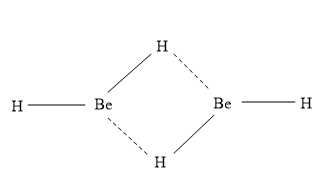
Which of the following contains three centre and two electron bonds?
(A)- ${\left( {{\text{Be}}{{\text{H}}_{\text{2}}}} \right)_{\text{2}}}$
(B)- ${\text{LiAl}}{{\text{H}}_{\text{4}}}$
(C)- ${\left( {{\text{BeC}}{{\text{l}}_{\text{2}}}} \right)_2}$
(D)- ${\text{L}}{{\text{i}}_{\text{2}}}{{\text{C}}_{\text{2}}}$
Answer
574.8k+ views
Hint: As the name suggests, ‘three centre and two electron bonds’ means we have to choose that compound in which 3 centers is presented as atoms and 2 bonds is present in the given compound.
Complete step by step solution: Three centre and two electron bonds containing compounds are generally electron deficient in nature because 2 electrons are shared in between three atoms.
Among the given options in the question option (A) i.e. ${\left( {{\text{Be}}{{\text{H}}_{\text{2}}}} \right)_{\text{2}}}$is correct, below is given some important points which throw light on the reason:
- Atomic no. of Beryllium (Be) atoms is 4 and its electronic configuration is$1{s^2}2{s^2}$ .
- There are 2 electrons in the valence shell, it means we use these 2 electrons for the formation of bonds.
- Among these 2 electrons, one electron forms a covalent bond with one hydrogen atom and another electron is used to form a banana bond with another hydrogen atom.
- In the given compound${\left( {{\text{Be}}{{\text{H}}_{\text{2}}}} \right)_{\text{2}}}$, total no. of Be atom is 2 and total no. of hydrogen atom is 4; among which 2 hydrogen forms covalent bond & another 2 takes part in the formation of banana bond.
- One Banana bond is formed by the 2 electrons between the 3 atoms but there is no uniform distribution of electrons among all 3 atoms, it is more towards the 2 atoms only.
- The structure of ${\left( {{\text{Be}}{{\text{H}}_{\text{2}}}} \right)_{\text{2}}}$is shown as:

- Here Be has $s{p^2}$ hybridization.
- Be-H-Be is a 3 centre between them 2 electron bonds are present, which is known as banana bond.
So, option A is the correct answer.
Note: In this question it is mentioned that between 3 centre, 2 electron bonds is present so never confuse with the Be-H bond because in this bond 2 centre is only present. And as Be forms 3 bonds but among these 3 bonds, electrons are not present in that bond which is shown by the dash line.
Complete step by step solution: Three centre and two electron bonds containing compounds are generally electron deficient in nature because 2 electrons are shared in between three atoms.
Among the given options in the question option (A) i.e. ${\left( {{\text{Be}}{{\text{H}}_{\text{2}}}} \right)_{\text{2}}}$is correct, below is given some important points which throw light on the reason:
- Atomic no. of Beryllium (Be) atoms is 4 and its electronic configuration is$1{s^2}2{s^2}$ .
- There are 2 electrons in the valence shell, it means we use these 2 electrons for the formation of bonds.
- Among these 2 electrons, one electron forms a covalent bond with one hydrogen atom and another electron is used to form a banana bond with another hydrogen atom.
- In the given compound${\left( {{\text{Be}}{{\text{H}}_{\text{2}}}} \right)_{\text{2}}}$, total no. of Be atom is 2 and total no. of hydrogen atom is 4; among which 2 hydrogen forms covalent bond & another 2 takes part in the formation of banana bond.
- One Banana bond is formed by the 2 electrons between the 3 atoms but there is no uniform distribution of electrons among all 3 atoms, it is more towards the 2 atoms only.
- The structure of ${\left( {{\text{Be}}{{\text{H}}_{\text{2}}}} \right)_{\text{2}}}$is shown as:

- Here Be has $s{p^2}$ hybridization.
- Be-H-Be is a 3 centre between them 2 electron bonds are present, which is known as banana bond.
So, option A is the correct answer.
Note: In this question it is mentioned that between 3 centre, 2 electron bonds is present so never confuse with the Be-H bond because in this bond 2 centre is only present. And as Be forms 3 bonds but among these 3 bonds, electrons are not present in that bond which is shown by the dash line.
Recently Updated Pages
Why are manures considered better than fertilizers class 11 biology CBSE

Find the coordinates of the midpoint of the line segment class 11 maths CBSE

Distinguish between static friction limiting friction class 11 physics CBSE

The Chairman of the constituent Assembly was A Jawaharlal class 11 social science CBSE

The first National Commission on Labour NCL submitted class 11 social science CBSE

Number of all subshell of n + l 7 is A 4 B 5 C 6 D class 11 chemistry CBSE

Trending doubts
What is meant by exothermic and endothermic reactions class 11 chemistry CBSE

10 examples of friction in our daily life

One Metric ton is equal to kg A 10000 B 1000 C 100 class 11 physics CBSE

1 Quintal is equal to a 110 kg b 10 kg c 100kg d 1000 class 11 physics CBSE

Difference Between Prokaryotic Cells and Eukaryotic Cells

What are Quantum numbers Explain the quantum number class 11 chemistry CBSE




